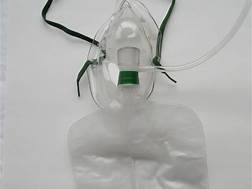A nurse is caring for a patient who is receiving oxygen therapy via nasal cannula. The nurse notices that the patient's nares are dry and irritated. What should the nurse do first?
Apply petroleum jelly to the nares.
Increase the flow rate of oxygen.
Change the nasal cannula to a face mask.
Connect the device to a humidifier.
The Correct Answer is D
Choice D rationale:
The nurse should connect the nasal cannula to a humidifier first. Dry and irritated nares are common side effects of oxygen therapy via nasal cannula, and using a humidifier adds moisture to the oxygen, reducing irritation and discomfort for the patient.
Choice A rationale:
Applying petroleum jelly to the nares is not the first action to take. It might provide temporary relief, but it is essential to address the root cause of dryness, which is the lack of moisture in the oxygen delivered.
Choice B rationale:
Increasing the flow rate of oxygen is not the first step because it may not address the dryness issue. It can lead to a higher concentration of oxygen, but it won't solve the problem of dry and irritated nares.
Choice C rationale:
Changing the nasal cannula to a face mask is not necessary to address the dryness. Face masks may not be well-tolerated by some patients, and it's better to try less invasive interventions first.
Nursing Test Bank
Naxlex Comprehensive Predictor Exams
Related Questions
Correct Answer is ["A","B","E"]
Explanation

The correct answer is choice a, b, and e.
Choice A rationale:
A non-rebreather mask is designed to deliver a high concentration of oxygen, often deemed the highest among low-flow systems. It achieves this through a reservoir bag that is filled with pure oxygen, which the patient breathes in without the dilution of room air.
Choice B rationale:
This mask has one-way valves that prevent the patient from rebreathing exhaled carbon dioxide. The exhaled air exits through side ports, ensuring that only oxygen from the reservoir is inhaled.
Choice C rationale:
While a non-rebreather mask delivers a high concentration of oxygen, it does not provide a consistent and precise oxygen delivery compared to devices like a Venturi mask, which are designed to deliver a specific and constant oxygen concentration.
Choice D rationale:
The design of a non-rebreather mask does not allow room air to enter through the exhalation ports. The one-way valves are there to ensure that exhaled air does not enter the reservoir bag and that room air does not mix with the oxygen being inhaled.
Choice E rationale:
By delivering a high concentration of oxygen and preventing the rebreathing of exhaled gases, a non-rebreather mask minimizes the risk of carbon dioxide retention, which can be a concern with other oxygen delivery systems that allow for the rebreathing of a portion of exhaled air.
In summary, the non-rebreather mask is advantageous for its ability to deliver a high concentration of oxygen and prevent the rebreathing of exhaled air, which also minimizes the risk of carbon dioxide retention. It is not designed for precise oxygen delivery, nor does it allow the mixing of room air during inhalation.
Correct Answer is C
Explanation
Choice A rationale:
Nasal cannula delivers oxygen through two small prongs placed in the patient's nostrils. While it is a commonly used and well-tolerated device, the FiO2 delivered can vary significantly depending on the patient's breathing pattern and respiratory rate. Thus, it does not provide the most precise and consistent FiO2.
Choice B rationale:
Simple face masks cover the nose and mouth and can provide higher FiO2 levels compared to nasal cannulas. However, the FiO2 delivered still depends on the patient's breathing pattern and the mask's fit, making it less precise and consistent than other options.
Choice C rationale:
Venturi masks are designed to deliver a specific and accurate FiO2, regardless of the patient's breathing pattern. These masks have adjustable ports to control the mix of air and oxygen, providing precise oxygen concentrations.
Choice D rationale:
Non-rebreather masks have one-way valves and a reservoir bag to deliver higher concentrations of oxygen. Although they can provide high FiO2 levels, the delivered concentration can vary based on the patient's breathing pattern and the mask's fit.
Whether you are a student looking to ace your exams or a practicing nurse seeking to enhance your expertise , our nursing education contents will empower you with the confidence and competence to make a difference in the lives of patients and become a respected leader in the healthcare field.
Visit Naxlex, invest in your future and unlock endless possibilities with our unparalleled nursing education contents today
Report Wrong Answer on the Current Question
Do you disagree with the answer? If yes, what is your expected answer? Explain.
Kindly be descriptive with the issue you are facing.
